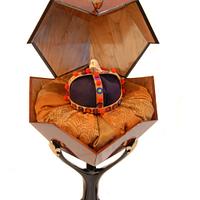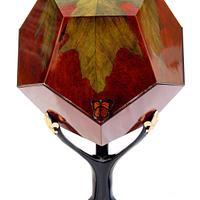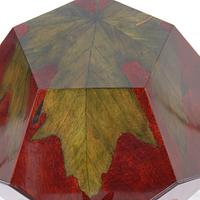Share your craft projects
Make new craft buddies
Ask craft questions
Blog your craft journey

shipwright
2135 posts
and
113 followers
in over 11 years
in over 11 years
Watercolour Dye Technique #2: New Lessons Learned from "Facets"
This is
part 2
in a
7 part
series:
Watercolour Dye Technique
-
General Concept
-
New Lessons Learned from "Facets"
-
Tips and Tricks I've Learned
...
- General Concept
- New Lessons Learned from "Facets"
- Tips and Tricks I've Learned
...
The biggest and most dramatic new lesson I learned from the "Facets" project's dyeing was the huge dimensional movement that you can get when you wet out this particular kind of veneer work. The most important thing learned from that experience is that if the pieces fit when you cut them they can be made to fit again, no matter how far out of whack they may seem to have gotten. It's only water and all you have to do is restore their original moisture balance. This can be done with a spray bottle or a hair dryer, depending on which way you have to go. This is well documented here: so there's no need to go over it again now.
.
The new area I wanted to experiment with in "Facets" was detailing within a color in a single piece. The big maple leaf on top was the subject. First of all I gave the whole leaf a wash of the shade of green I wanted for background color.

Then I applied a darker shade and even some black "wet on dry"to form curled up details in some of the tips and edges. I found that if I held a hair dryer with it's hot air aimed at the brush I could keep a quite bleed free line. I decided to try this after the leaves in "Cabinetree" showed me that I really didn't have to use the walnut bits to show dark edges.

Here it's about 1/2 done and you can see some of the detail is coming along nicely. Wet on dry lines that follow the grain work quite well even without the dryer.

In this photo the pieces are assembled into their backgrounds and adhered to their substrates but have suffered from the washing out that resulted from the dimensional stability problem. Now I had to see if the work could be repaired post assembly. I suppose I should explain the caterpillar. When I was double bevel cutting the corner pieces into the leaf center piece, I accidentally made the cut for the larger top right corner in the bottom left. The caterpillar covers most of the boo boo.

He had to be hand cut in and created his own dying challenges.

Since I wanted to darken the background color anyway, I decided to test the barrier qualities of the glue line with that color before going on to the leaf repairs. The last time I tried this the glue line was CA glue and did not present any barrier at all to dye bleeding. This was a different glue line. Firstly it was urea formaldehyde glue and secondly it had been vacuum bagged, probably giving it a better fill between the pieces. At any rate the glue line held as you can see in this photo. Once I knew this it was just a matter of repeating the previous steps albeit more carefully to re-create the lost detail. The whole process seems to be amazingly forgiving.

I chose to make a butterfly for the lift handle and dyed it with a simple wet on dry system. I discovered later that I could have done the fine detail after the first bit of poly and gotten better lines, but I don't mind this.

Here's a finished shot of the leaf panels with finish applied. The colors in the piece actually look more vibrant that they do in the photos but the extreme gloss and the many planes make it very hard to photograph.

That's it for this segment. Hope I've cleared up a little more of the mystery here and that some of you will jump in and clear up some more of it.
I'll do one more segment to discuss a few observations and tricks I've learned along the way.
For now Thanks for enduring and let's see some of you dyeing stuff.
Thanks again
Paul
The early bird gets the worm but its the second mouse that gets the cheese.











